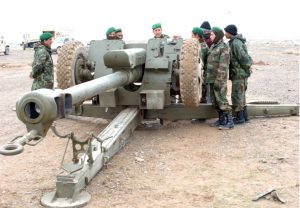The collapse of the Afghan government and its replacement with the Taliban has precipitated a humanitarian crisis and a political reckoning in the West about the limits of political will and military power.
It has also brought to the fore, once again, the question of what happens to weapons after the war they were bought for comes to an end – especially when they were bought by the losing side.
The United States, as has been widely reported, spent an enormous amount on training and equipping the Afghan National Army and Air Force – some $83 billion since 2002. Though some of this equipment has been lost or destroyed in battle, the bulk of it is now in the hands of the Taliban.
The first thing to note is that none of this equipment is likely to change the strategic balance outside Afghanistan. The Afghan security forces were equipped to fight against irregular opponents on its own territory, not to launch offensives across national boundaries. Given that the Taliban never fielded an air force, there were no shoulder-fired missiles in the Afghan inventory that could be used to target civilian airliners, no ballistic or cruise missiles, and no long-range strike aircraft. What was left behind can be used for internal repression and propaganda – neither of which should be ignored – but will not suddenly transform the Taliban into an expeditionary military.
There is an interesting (though less urgent) question about the fate of the several dozen planes and helicopters apparently flown by Afghan pilots to Uzbekistan, including the bulk of the Afghan Air Force’s A-29 Super Tucano light attack aircraft. The Uzbek government might choose to return them to the Taliban, once it solidifies its control of the country; or to sell them back to the United States in exchange for some kind of political or financial incentive; or to simply keep them and use them to supplement its own air force. But again, none of those systems represents either a meaningful intelligence loss to the West nor a strategic threat.
More fundamentally, though, many of those weapons cannot simply be used in perpetuity by their new owners. In general, the more complex a weapons system is, the more onerous its maintenance requirements are. Simple weapons, like rifles, can last decades (or longer) in rough conditions and with minimal maintenance. Likewise, basic vehicles – pickup trucks, for example, which are the building blocks of armed mobility for many irregular forces worldwide – can be kept running with ingenuity and a degree of mechanical knowledge. But systems such as aircraft, computerized sensor systems, modern armored vehicles and so on all require specialized parts, complex maintenance procedures and – increasingly – regular software updates to keep them effective, or even functional.
Indeed, the withdrawal of U.S. technical and logistical support – agreed to by the Trump administration as part of its February 2020 deal with the Taliban and not reversed by the Biden administration – did real harm to the ability of the Afghan army and air force to fight as they had been trained and equipped for. Some of the more sensitive electronic systems were literally stripped out and taken back to the United States; in a grim irony, those left behind only threaten the West’s Afghan allies.
The degree to which weapons are only effective thanks to the continued support of their creators has been increasing as weapons become more complex and networked. Even fairly recently, it was not always thus: the Islamic Republic of Iran still operates a huge quantity of U.S.-made weapons, which fell into its hands after the 1979 revolution that overthrew the U.S.-aligned monarchy. In addition to keeping these systems functional for decades – including some, like their now-unique fleet of F-14 Tomcat fighter jets, that were state-of-the-art when the revolution occurred – they have managed to reproduce and even modestly upgrade them. And the inventories of smaller countries with a recent history of conflict are still littered with small numbers of weapons captured from adversaries or rebel groups, or brought over by defectors.
But there is a profound difference between a mechanical system and a computerized one. A mechanical system, no matter its complexity, can be reverse-engineered given enough resources. Indeed, the first Soviet strategic bomber of the Cold War, the Tupolev Tu-4, was a near-carbon copy of the U.S. B-29 Superfortress, a few of which were impounded by the Soviets after making emergency landings on Soviet territory. The most modern warplanes, by contrast, require regular interfaces with highly sophisticated software tools to function. Software can be hacked, to be sure – but it can also provide a means by which the original owner can sabotage assets that have fallen out of their control. That would not even take active hacking; systems can be programmed to require regular check-ins in order to maintain functionality.
That, however, is an imperfect tool. Whether militaries – or the operators of such systems whose lives in a very real way depend on them – would be willing to adopt, on a wide scale, systems with such dependencies built into them is an open question. But as Afghanistan demonstrates once again, weapons frequently have lives far beyond their original owners and intentions.

































